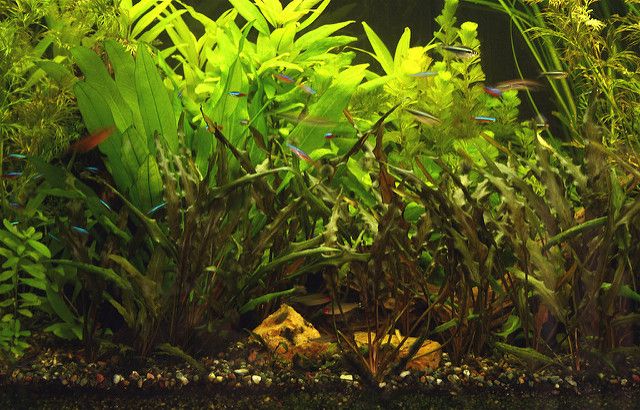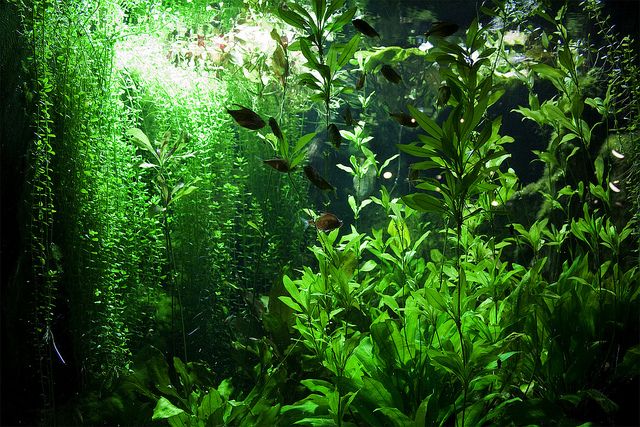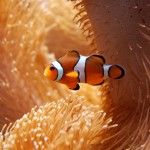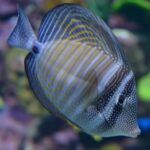As with everything in life, in the aquarium hobby sometimes less is more. We all love the high-tech aquascapes with lush plants but in some cases you just have to go the simple route and keep things low light and low maintenance. It’s easier, it’s cheaper and you can still set up a beautiful tank without powerful lights. You just have to know which plants to go for!
Keep reading for a list of 5 low light aquarium plants that are perfect for your next planted tank.
Anubias (Anubias barteri, Anubias ‘nana’, etc.)
What most aquarists think of first when they hear ‘low light’ is Anubias, especially the common Anubias barteri and its smaller cousin Anubias ‘nana’. These rhizomatous plants actually grow best under low light in most cases: strong lighting often results in algae covered and dying leaves.
Anubias varieties are very easy to grow and even beginners should be able to keep them alive without much issue. Tie or glue this plant to porous rock or driftwood rather than planting it in the substrate. This might seem a little odd, but Anubias has actually evolved to anchor itself on textured surfaces using its extremely strong roots.
Java fern (Microsorum pteropus)
Very similar to Anubias in terms of care and planting but not at all in appearance is Java fern. This aquatic fern is popular among beginners and anyone wanting to go the low-tech route because of its adaptability and easy care. Not the quickest grower around, but once it gets going this plant is definitely the definition of ‘lush’.
As with Anubias, you should attach Java fern to rock or driftwood if you want it to thrive. Its roots aren’t adapted to growing in substrate (unless it’s very coarse) and it might die off if planted incorrectly.
Crypts (Cryptocoryne wendtii, etc.)
If you’re looking to go for the jungle effect in your low-light aquarium, be sure not to overlook Cryptocoryne. This species won’t mind a less bright environment; it’ll just grow taller to make up for the lack of light, which makes for a beautiful effect.
Cryptocoryne can be planted in the substrate and doesn’t need much in terms of care once it has settled. It can take a while before this plant gets going, though, so don’t give up too quickly. Major leaf loss is entirely normal if you’ve just planted this species. Keep in mind that colored cultivars like the hot pink Cryptocoryne ‘flamingo’ might lose their distinctive coloration and revert to green if they’re not getting enough light, so you might want to avoid those.

Amazon sword (Echinodorus bleheri)
If you’ve got a large aquarium and need to fill up all that empty space, look no further. Echinodorus bleheri, better known as Amazon sword, can produce leaves with a length of up to 20 inches. It does so quickly, too: this is a very fast grower that doesn’t need much to thrive.
This blade-shaped foliage is sure to green up any aquarium and makes a perfect addition to the background of your tank. Low-light conditions are no problem for Amazon swords and no nutrient dosing is needed, although a root tab here and there will be appreciated.
Vallisneria spiralis
Another easy aquarium plant that will make do with small amounts of light just fine is Vallisneria spiralis. This is one of the smaller types of Vallisneria and unlike some of its cousins like the massive Vallisneria americana it works in most types of aquariums including nano tanks.
Vallisneria leaves are reminiscent of sea grass and a well-established field of these plants will look beautiful waving in the current of your filter. Healthy Vals multiply quickly by producing runners and will form dense patches in no time. You can leave the runners to grow where they are, move them to a better spot or even sell or give them away. You’ll have more than you know what to do with before you know it!
Your Planted Tank Made Easy
A low-light aquarium with undemanding plants like the species discussed above is not too difficult to set up, but you’ll still have to do plenty of research and invest some time into getting things right. If you’re too busy to spend hours browsing the internet for information on obscure aquarium plants, why not let us help you?
If you want to enjoy a lush green aquascape in your home without all the hassle, feel free to contact us here and we can set up and maintain your tank for you.




